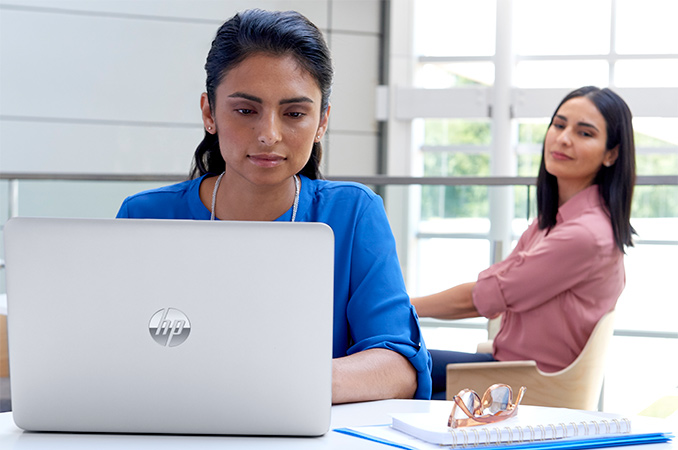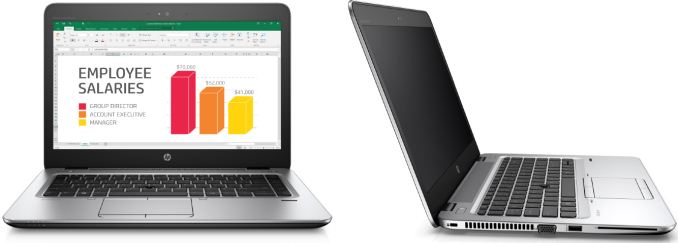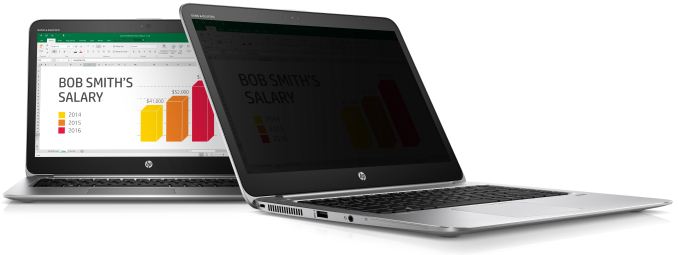HP Announces EliteBook Laptops with On/Off Sure View Privacy Screens
by Anton Shilov on August 26, 2016 10:30 AM EST
On Thursday, HP introduced adjustable privacy screens for the EliteBook 840 as well as the EliteBook 1040 notebooks. These are aimed at business users concerned about visual hacking and disclosing sensitive information to onlookers (something a number of journalists have to consider when working on NDA information when flying back from a press event). The protective measures for the screens are based on the Sure View technology jointly developed by HP and 3M, which relies on a number of HP’s proprietary technologies as well as 3M’s optical films. Ultimately, the user can control the privacy with an on/off switch as required, rather than equipping a perminant film that can reduce comfort. Right now, the Elitebook laptops are the first batch to get the technology, but eventually HP’s Sure View technology may appear on other PCs from the company depending on feedback.
In the conference call, HP was keen to point out that according to the Pew Research Center, around 60% of employees nowadays take their work outside of office walls and can potentially (without knowing) share confidential information with the wrong people. Most users that have to work while on the move might not be aware of who is staring at their displays from the back or from the side (which is incredibly annoying in general even if you are playing Tetris). Knowing that, HP explained that some employees tend not to work with sensitive data in public places, which can reduce their overall productivity. Meanwhile there is a market to ensure privacy in cafes, airports and other venues - other people install aftermarket privacy screens on their laptops. While that helps businesses to better comply with regulatory requirements in healthcare, finance and industries dealing with sensitive information, such screens reduce viewing angles of notebooks which affects overall user experience. By contrast, HP’s Sure View can be turned on and off, thus improving privacy without persistent reduction of viewing angles of laptop screens.
HP’s Sure View technology uses a special film from 3M as well as HP’s own backlighting. When the setting of the backlighting is adjusted, the film decreases viewing angles of the display down to around 35 degrees. The tech can be activated by pressing Fn + F2 and actual viewing angles can be further adjusted by pressing other combinations of buttons (viewing angle adjustments are independent of brightness and one is not dependent on the other). HP claims that the technology can be used with different display panels, but initially the company will use the technology on TN or SVA panels with FHD resolution. The Sure View does not consume extra power and since it relies on different setting of the backlighting, it might help to improve battery life a bit. HP does not reveal the price of its integrated privacy screen technology, but claims that with higher-end configs it will be virtually free. Moreover, the company mentioned that since it is not just a film on top of the display itself, it is going last throughout the lifetime of the laptop.
As for configurations, the HP EliteBook 840 G3 and the HP EliteBook 1040 G3 are 14” laptops based on Intel’s dual-core Core Skylake-U chips with integrated HD Graphics 520 and vPro (select models only). They come with up to 32 GB of DDR4-2133 memory and use 2.5” HDDs/SSDs (EliteBook 840) or M.2 SSDs (EliteBook 1040). The notebooks are equipped with 802.11ac WiFi + Bluetooth modules, Gigabit Ethernet (via dongle in case of the 1040) as well as an LTE or HSPA+ WWAN module. As with many business PCs, the systems are equipped with anti-spill keyboards, fingerprint readers (optional in case of the 840) and TPM 1.2/2.0 modules.
Both laptops feature 14” display panels and are fairly light and thin for mainstream business models. The EliteBook 840 weighs 1.48-1.7kilograms and is 1.89-2.02cm thick (the peak values for touch-enabled models. Meanwhile, the EliteBook 1040 weighs starting at 1.43 and is 1.58-1.65cm thick. Depending on the exact configuration, the EliteBook 840 can work for up to 13.5 hours, whereas the EliteBook 1040 can boast with 10 to 11.5 hours of battery life. Since configurations of the notebooks can vary, HP does not mention recommended prices, but we are talking about machines that start at around $1200 and can end up at $2000 or higher. B2B sales will differ in price depending on volume and support packages. Users should see systems with Sure View privacy screens available in September.
Source: HP


















43 Comments
View All Comments
JoeyJoJo123 - Saturday, August 27, 2016 - link
That's not exactly the correct way to do things, especially for an HR department, and therefore isn't the safest way to keep confidential information of customer information and employment terms secure.Consider the incredibly unlikely event that the company is near bankruptcy and needs to lay off half of its employees to continue to function, including HR. How do 3 HR employees keep confidential information such as the status of the other 2 HR employees' end of employment?
Therefore, on any occasion, every HR employee should be able to function independently and confidentially from one another, even if on a day-to-day basis there may be no risk of other HR employees being terminated from their position.
Also, if I were to give anecdotal evidence, such as "You have never worked in a McDonalds, have you? At my work, there's 5 frycooks picking their noses and flicking boogers into the fryer," you can't seriously expect that this single piece of anecdotal evidence is proof of how all McDonald's _should_ function.
There's a distinct difference between the way someone's particular office handles a process and the way all offices _should_ handle that process.
BrokenCrayons - Friday, August 26, 2016 - link
The details of the article make it apparent this isn't something that's simply turned on or off as needed, but a coating that reduces the viewing angle as brightness decreases. In reality, this sort of thing happens already to a much lesser extent on cheap TN panels as the user reduces brightness. The way AT presents the feature initially would lead one to believe it's some sort of active filtering, but it doesn't appear that way. The Fn+F2 keyboard combination is probably just a shortcut to an appropriately reduced brightness level where the filter becomes more effective.Wardrop - Friday, August 26, 2016 - link
The details of your comment make it apparent you didn't read the whole article :P To quote the article: "viewing angle adjustments are independent of brightness and one is not dependent on the other"BrokenCrayons - Saturday, August 27, 2016 - link
I don't think the article is very well written. This line: "HP’s Sure View technology uses a special film from 3M as well as HP’s own backlighting," clearly implies relevance to the backlight's importance in the combination of technologies that contribute to reducing viewability.Wardrop - Sunday, August 28, 2016 - link
Yes, and given every backlight can adjust it's brightness, the article implies HP's backlight is capable of more than that. Perhaps it's something to do with polarisation or something like that.beginner99 - Friday, August 26, 2016 - link
Yeah I always wondered what the big deal with viewing angles is. As long as it's good enough to not affect a single user, no issue. why would you need 160 degree viewing angles anyway?peterfares - Saturday, August 27, 2016 - link
Because generally the higher the rated viewing angle, the less distortion there is at smaller viewing angles, too. TN screens supposedly have something like 160 degrees of viewing angle but they start to look terrible even if you're just 30 degrees off center.tipoo - Friday, August 26, 2016 - link
Funny, but this is an optional feature with a button press. Enjoy the wide angles when you want, use the privacy mode for sensitive stuff in public.jimjamjamie - Friday, August 26, 2016 - link
"Ultimately, the user can control the privacy with an on/off switch as required, rather than equipping a perminant film that can reduce comfort."> perminant
Sushisamurai - Friday, August 26, 2016 - link
I can see this being very useful in the healthcare environment, where you have multiple open comps and desktops running in an "open" area (like a ward). Not to mention the new trend of carrying a hospital laptop to write patient notes instead of thick ass charts. Patient privacy is still a concern, even among other docs working in the physician lounge (although most don't care and or don't snoop anyways)